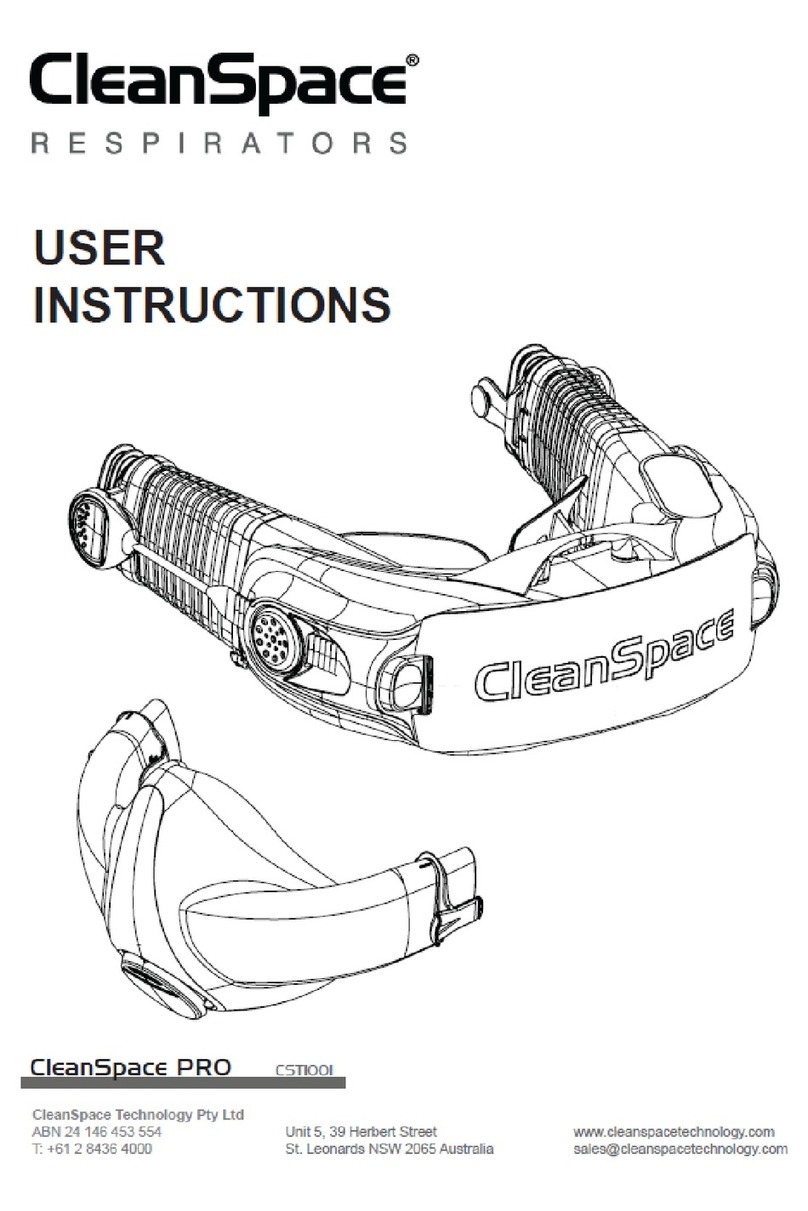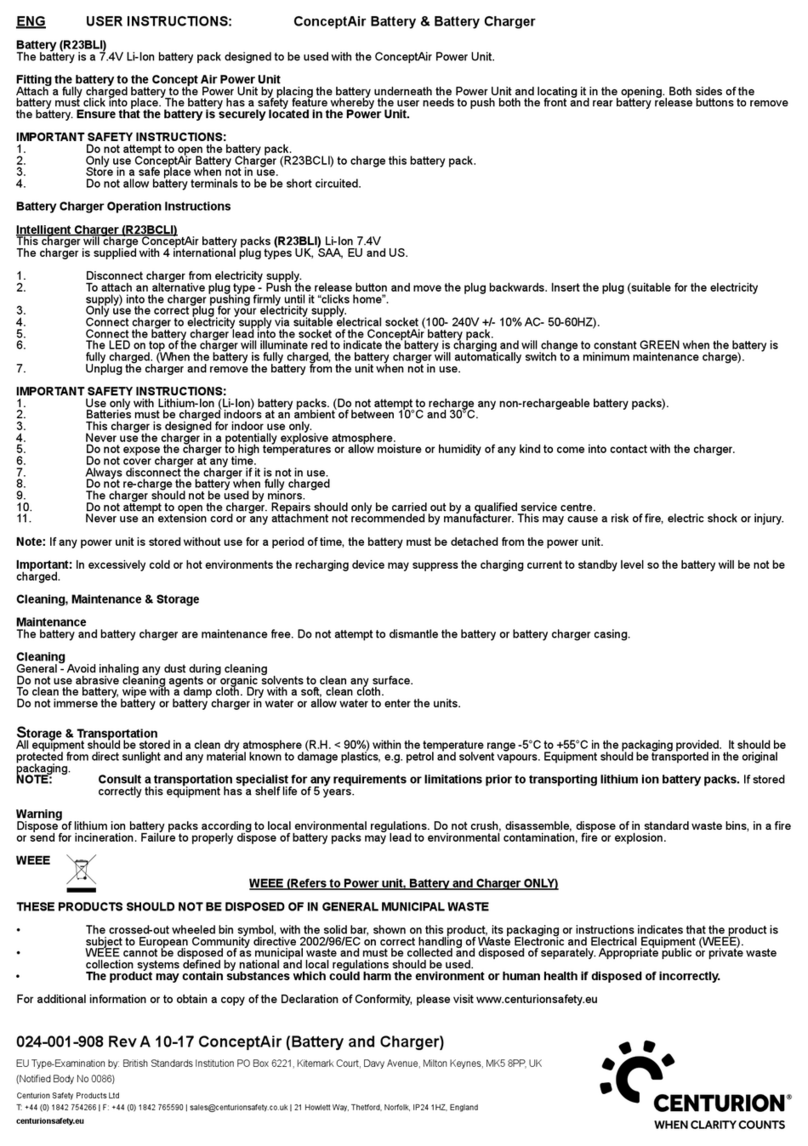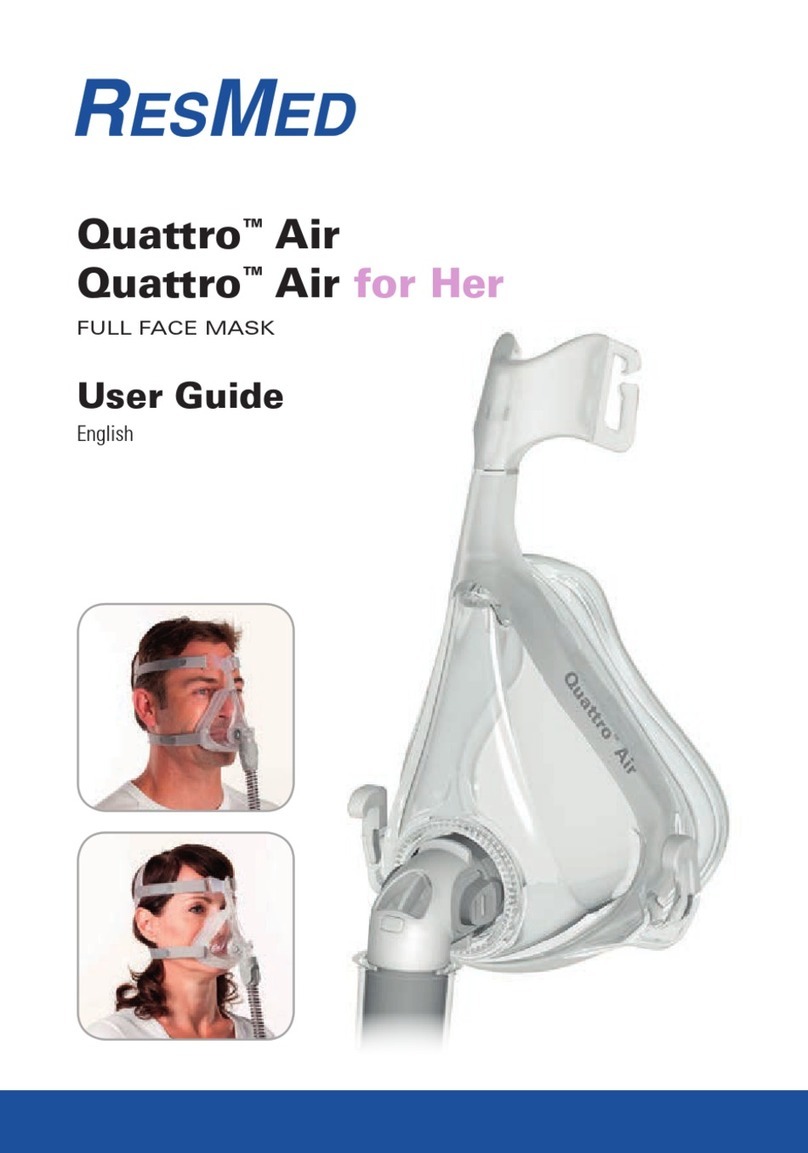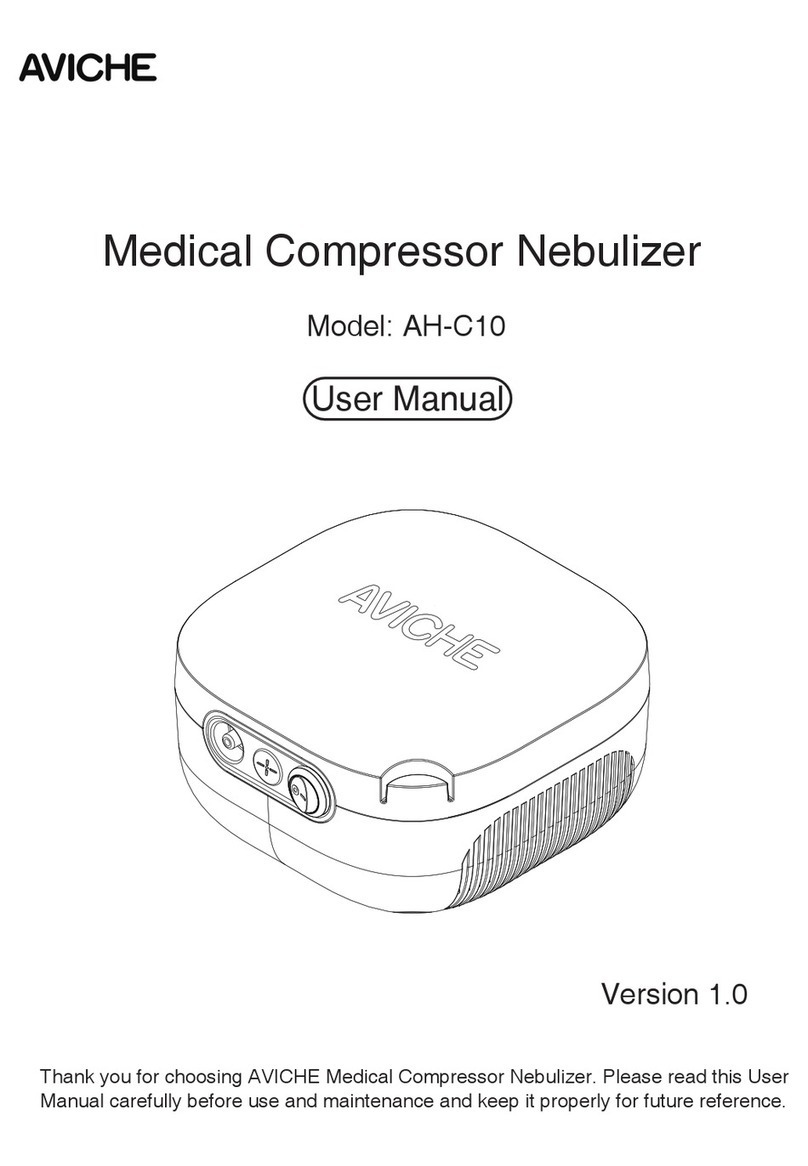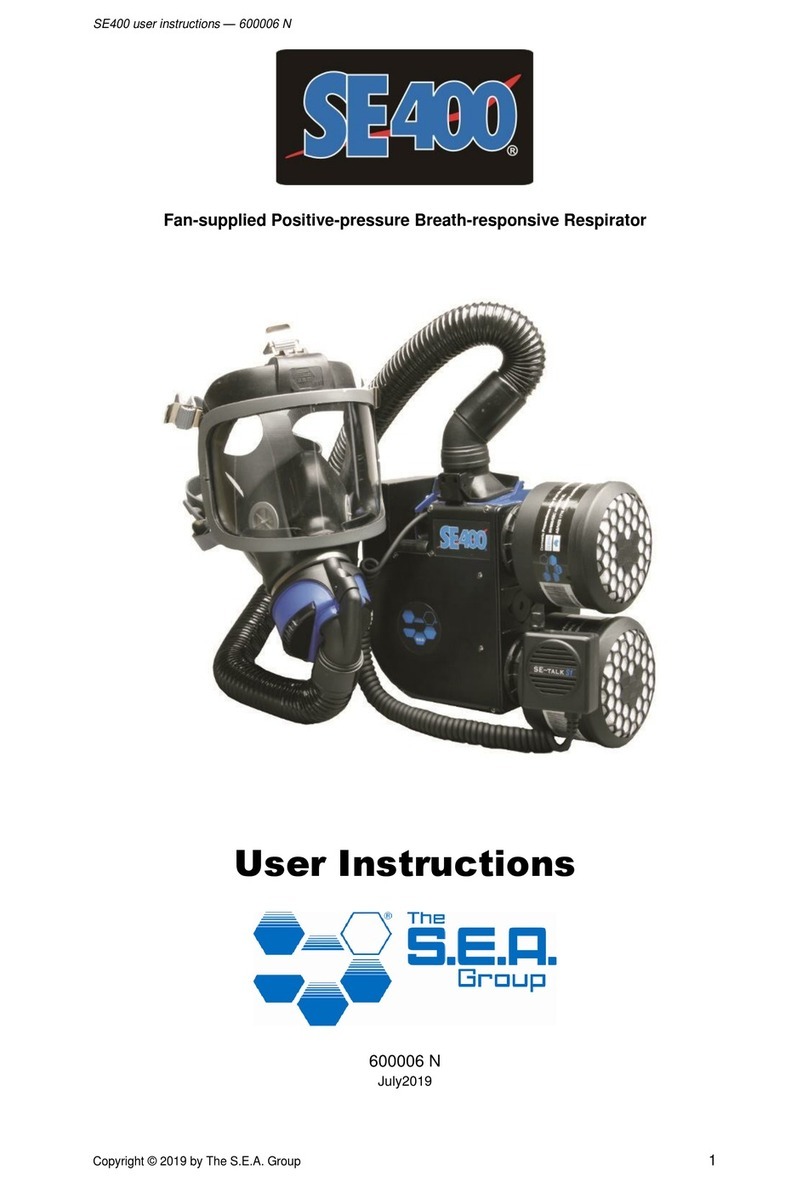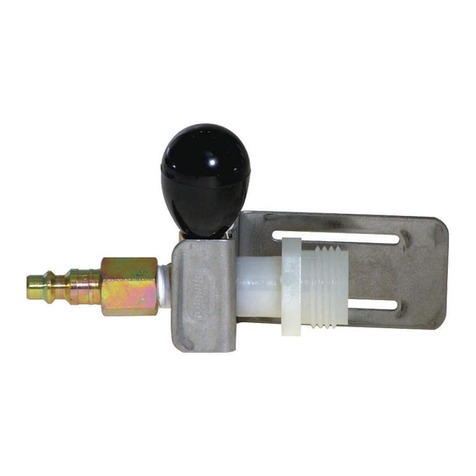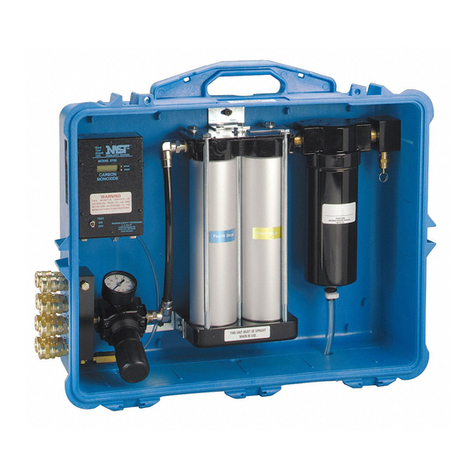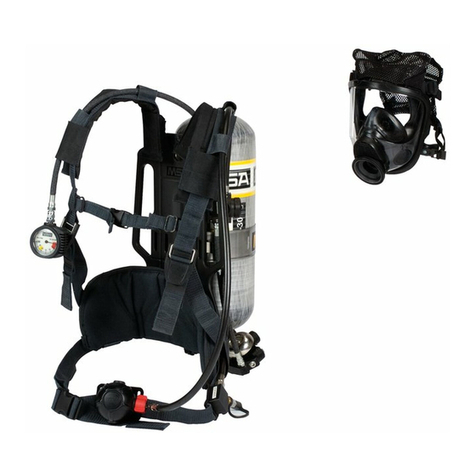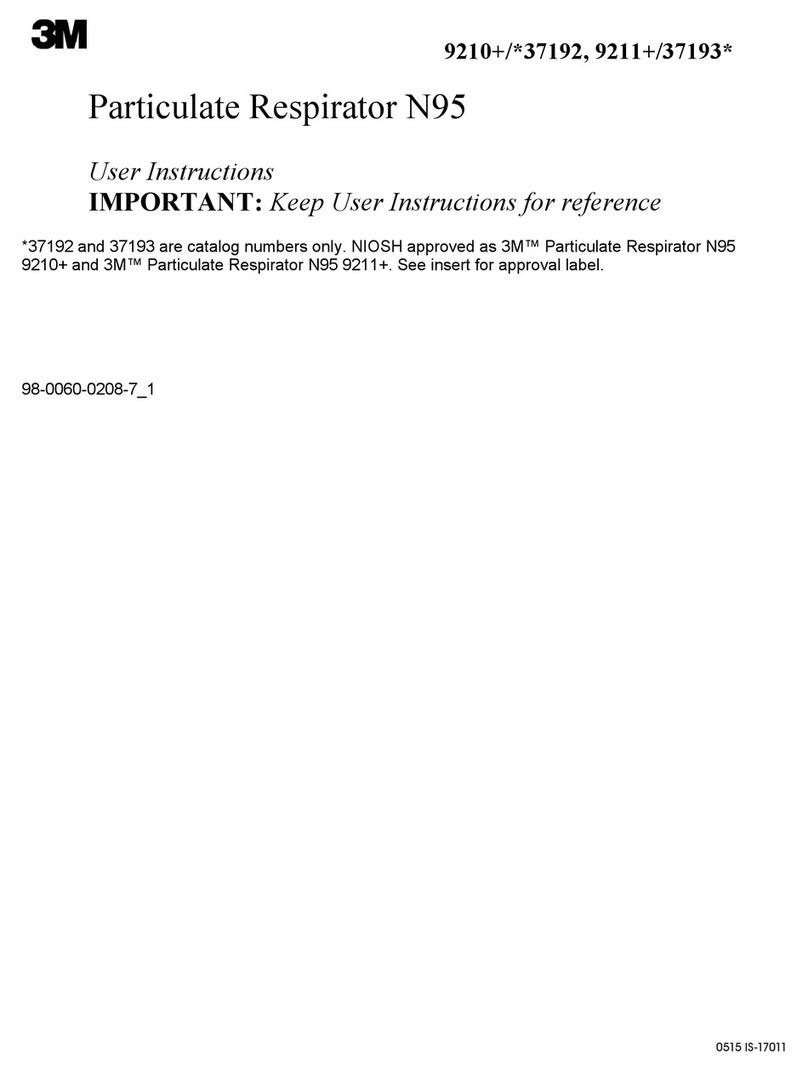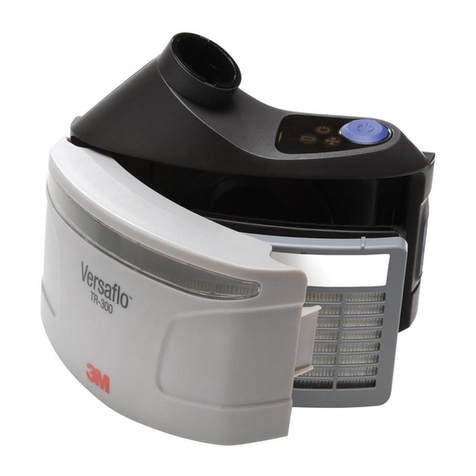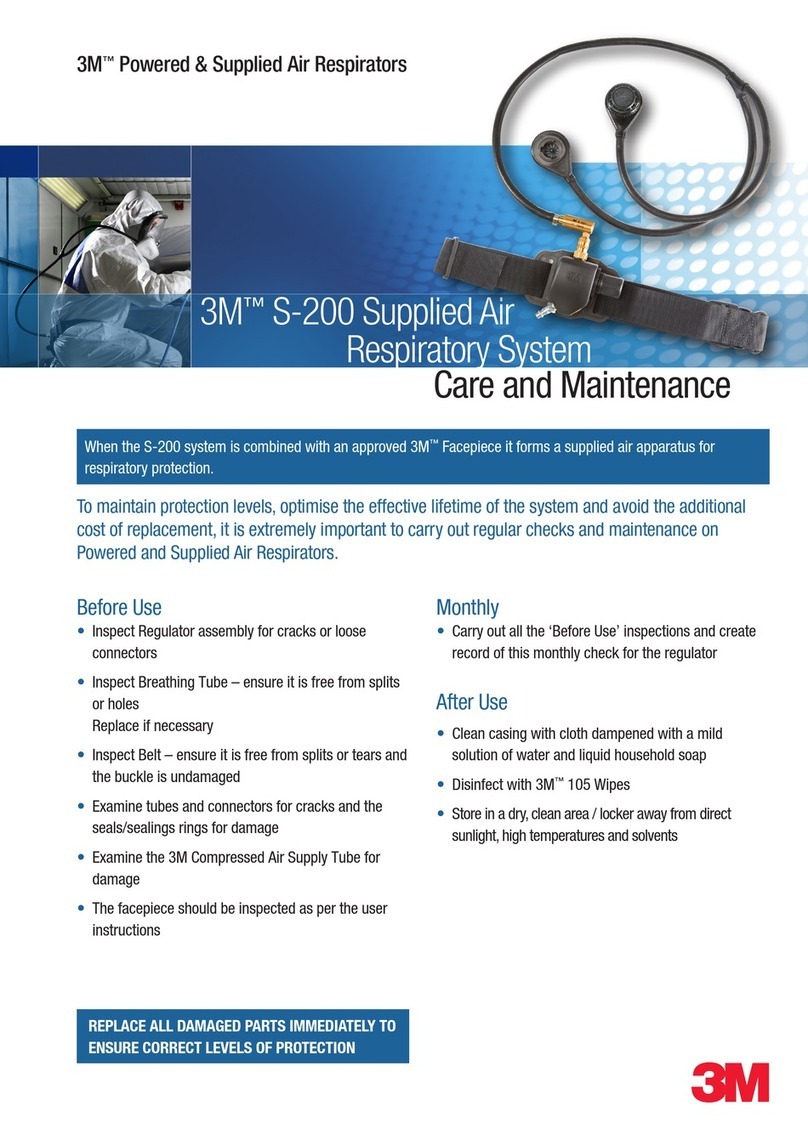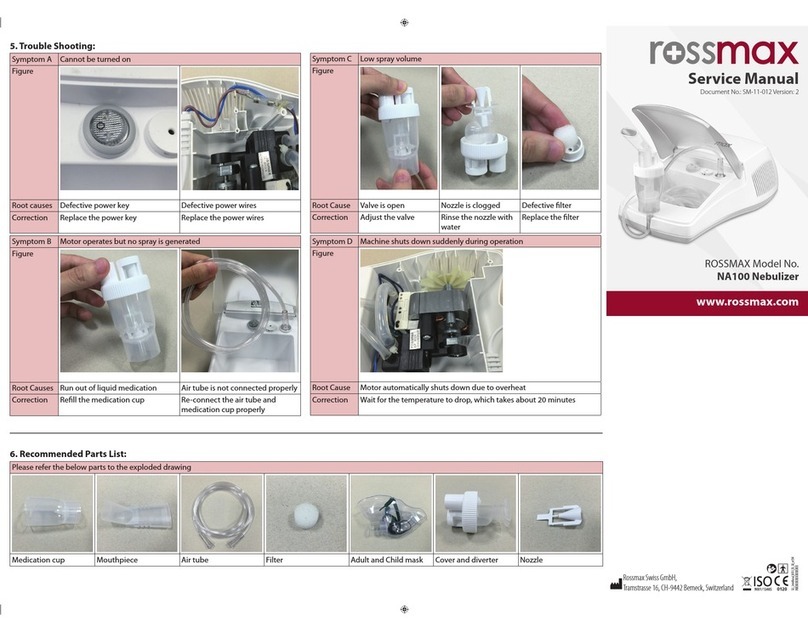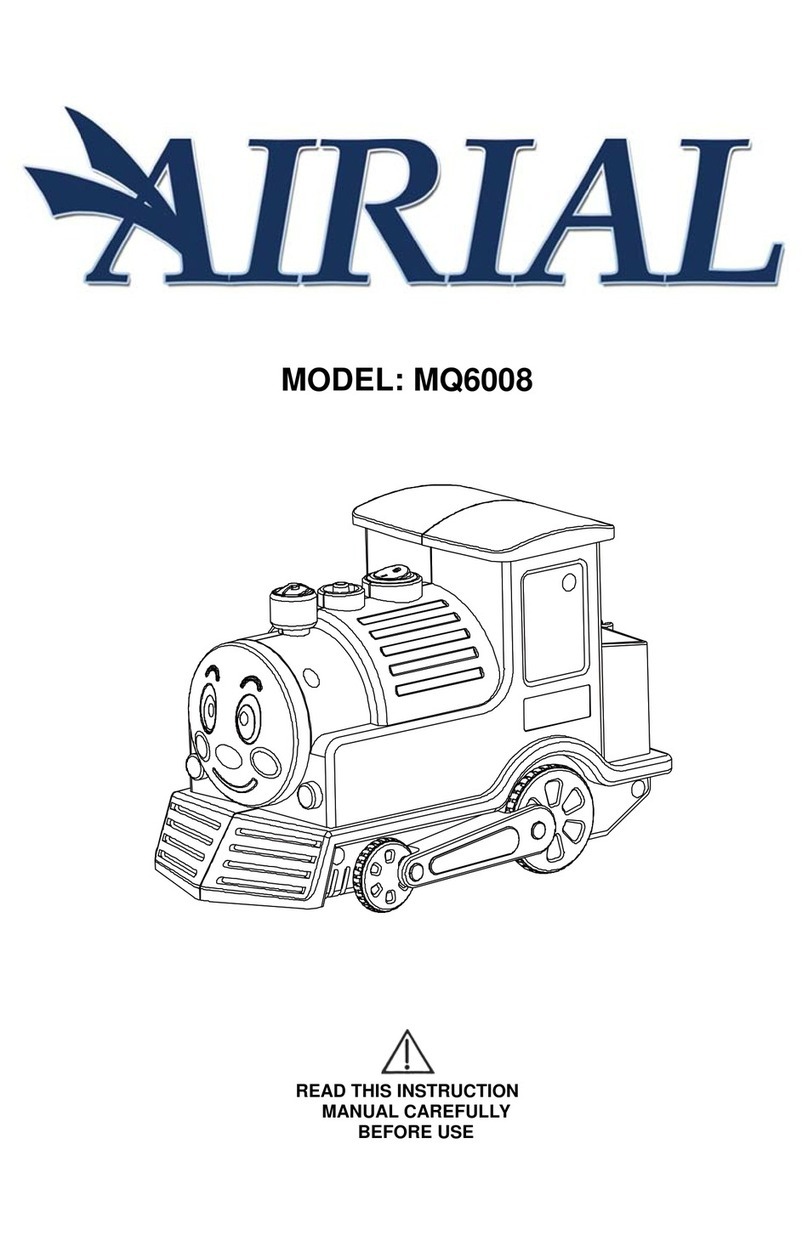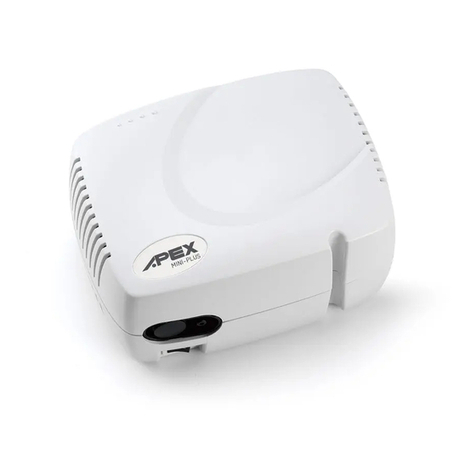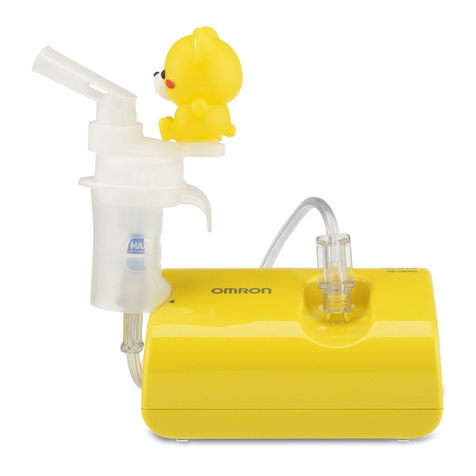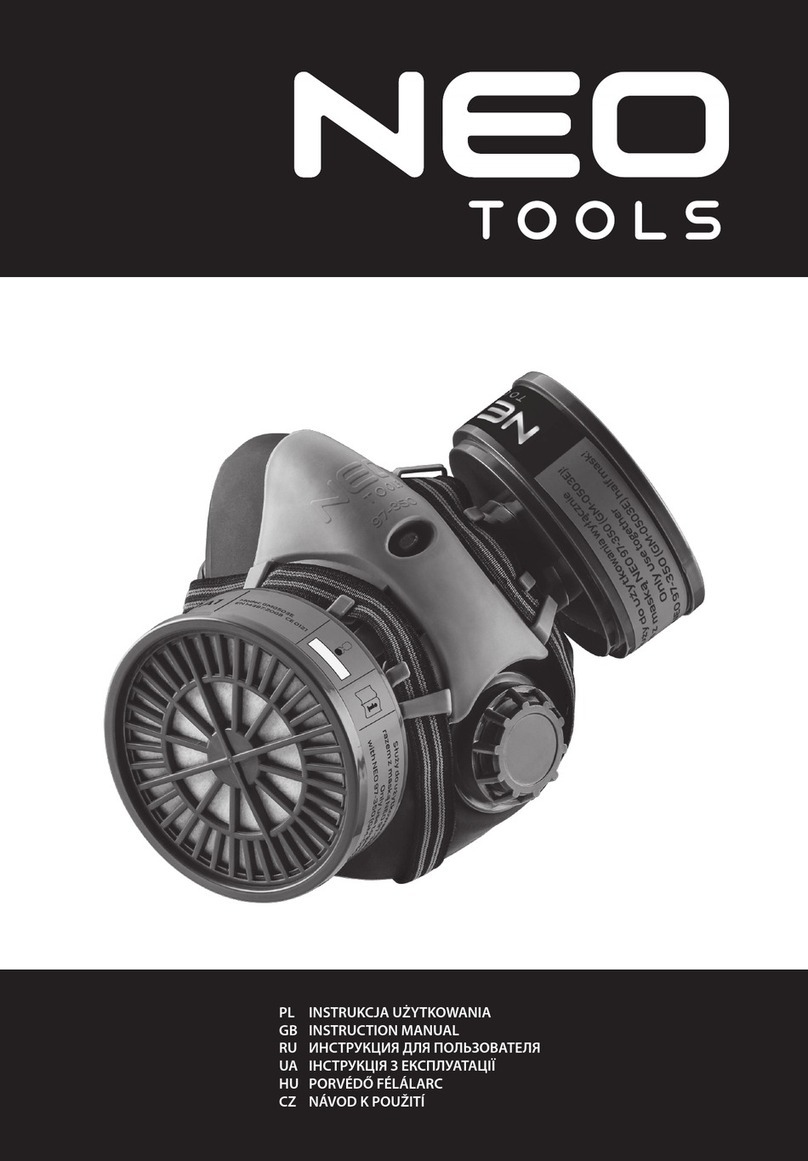CleanSpace ULTRA User manual

Important! Before use, the wearer must read and understand
these user instructions. Keep these user instructions for
reference.
CleanSpace ULTRA
Powered respirator
USA - English
www.cleanspacetechnology.com
USER
INSTRUCTIONS

2
1. Contents
1. Contents............................................................................................................................................................... 2
2. Foreword .............................................................................................................................................................. 2
3. System Description .............................................................................................................................................. 3
4. List of Warnings within these User Instructions .................................................................................. 3
5. NIOSH – Approval, Cautions and Limitations ..................................................................................................... 4
6. S - Special or Critical User Instructions ............................................................................................................... 5
7. Limitations of Use ................................................................................................................................................ 5
8. Respirator Program Management ....................................................................................................................... 6
9. System Components............................................................................................................................................ 7
10. Controls and Indicators ........................................................................................................................................ 8
11.Mask Fitting.......................................................................................................................................................... 9
12. Donning the Respirator...................................................................................................................................... 11
13. Entering and Exiting the Contaminated Area .................................................................................................... 17
14. Working in Noisy Environments......................................................................................................................... 18
15. Fitting & Changing the Filter .............................................................................................................................. 18
16. Battery Information............................................................................................................................................. 20
17. Cleaning ............................................................................................................................................................. 22
18. Periodic Maintenance & Checking..................................................................................................................... 24
19. Appendix - Performing a Quantitative Fit Test .................................................................................................. 25
20. Specifications ..................................................................................................................................................... 27
21. Product and Accessory information................................................................................................................... 28
22. Product Warranty ............................................................................................................................................... 29
Read these instructions in conjunction with the appropriate CleanSpace™filters and accessories instructions.
WARNING
This product is part of a system that helps reduce exposure to certain airborne contaminants. Misuse
may result in sickness or death. For proper use, see your Occupational Health Specialist, these
user instructions or contact Customer Service on 1 888 804 0038
2. Foreword
Read all instructions and warnings before using this device. Keep these user instructions for reference. If you have
questions regarding this system contact Customer Service on 1 888 804 0038 or e-mail
sales@cleanspacetechnology.com.

3
3. System Description
CleanSpace ULTRA is a complete NIOSH approved respiratory protection system (“respirator”). When used in
accordance with its NIOSH approval, the respirator helps reduce exposure to certain particulates. CleanSpace
ULTRA does not provide protection against vapours or gasses. See NIOSH Cautions and Limitations and the
Approval Labels for CleanSpace ULTRA.
The components of the CleanSpace ULTRA system are shown in Section 9. The blower draws ambient air through
the high efficiency filter and filter adaptor and supplies filtered air to the wearer via the mask. CleanSpace ULTRA is
a breath responsive respirator which means that it blows harder during inhalation and more softly during exhalation.
The device continuously adjusts fan speed to maintain positive pressure in the mask. Should the filter become
blocked, an audible alarm will sound and the “Filter” light on the keypad will be illuminated. If the battery voltage falls
below the minimum required to sustain the designed flow rate, an audible alarm will sound.
WARNING
Properly selected, used and maintained respirators help reduce exposure to certain airborne
contaminants. It is essential to follow all instructions and government regulations on the use of this
product, including wearing the complete respirator system during all times of exposure, in order for
the product to help protect the wearer. Misuse of respirators may result in overexposure to
contaminants and lead to sickness or death. For proper use, see your Occupational Health
Specialist, these user instructions or contact Customer Service on 1 888 804 0038
4. List of Warnings within these User Instructions
WARNING
This product is part of a system that helps reduce exposure to certain airborne contaminants. Misuse may result in sickness or death. For proper use,
see your Occupational Health Specialist, these user instructions or contact Customer Service on 1 888 804 0038
WARNING
Properly selected, used and maintained respirators help reduce exposure to certain airborne contaminants. It is essential to follow all instructions
and government regulations on the use of this product, including wearing the complete respirator system during all times of exposure, in order for
the product to help protect the wearer. Misuse of respirators may result in overexposure to contaminants and lead to sickness or death. For proper
use, see your Occupational Health Specialist, these user instructions or contact Customer Service on 1 888 804 0038
This respirator contains a system for synchronising with your breathing and regulating mask pressure. This system requires re-calibration whenever
it experiences a change in temperature of more than 36°F (20°C). It is best practice to also re-calibrate if the unit has been in storage, particularly if
the storage temperature is not known.
For the most accurate battery charge indication, the respirator must be plugged into its charger. To be sure it is fully charged, plug in the charger and
wait for all 3 LEDs to light solidly without flashing. If the 3rd LED is flashing rapidly, the battery is 95% charged.
IF A SATISFACTORY FIT FACTOR CANNOT BE ACHIEVED WITH ANY OF THE MASKS, THE RESPIRATOR MUST NOT BE USED
After using the on-board fit test port:
To check that the test port plug is fitted correctly, a negative pressure seal test shall be performed – see page 14
DO NOT USE COMPRESSED AIR OR A BRUSH TO CLEAN THE FILTER!
HE FILTERS ARE VERY EASILY DAMAGED BY COMPRESSED AIR OR BY BRUSHING.
Misuse by cleaning the filter may result in overexposure to contaminants and lead to sickness or death.
IF A SATISFACTORY FIT CANNOT BE ACHIEVED, DO NOT ENTER THE CONTAMINATED ZONE
DO NOT REMOVE THE RESPIRATOR UNTIL YOU HAVE
VACATED THE CONTAMINATED AREA unless you have pressing health reasons to do so (for instance you are experiencing dizziness and believe
removing the respirator while you leave the contaminated area may help)
IT IS ESSENTIAL THAT THE CORRECT FILTER TYPE IS SELECTED FOR THE CHOSEN APPLICATION.
If the blocked filter alarm is triggered (2 beeps, repeated every second, red LED flashes), leave the contaminated area immediately and replace the
filter. Operating the respirator after the blocked filter alarm has sounded can cause the flow to fall below the manufacturer’s minimum designed flow,
which may result in overexposure to contaminants and lead to sickness or death.

4
WHEN FITTING A NEW FILTER THE BLOCKED FILTER ALARM SHALL BE TESTED BEFORE THE RESPIRATOR IS PUT BACK INTO SERVICE. SEE “TESTING THE
BLOCKED FILTER ALARM”
Use only NIOSH-approved CleanSpace filters. If used with other filters CleanSpace respirators are not NIOSH approved. Use of other filters may result
in overexposure to contaminants and lead to sickness or death
Always correctly use and maintain the internal lithium ion battery packs. Failure to do so may result in fire or explosion or could adversely affect
respirator performance and result in injury, sickness or death. Do not charge the on-board battery with unapproved chargers, in enclosed cabinets
without ventilation, near flammable liquids or gasses, or near sources of high heat. Do not immerse the device in water. Do not use, charge or store
the device outside the recommended temperature limits
WARNING: The battery shall only be charged in non-hazardous areas. Move out of the hazardous area before charging
If the battery alarm sounds (3 beeps, repeated every second), leave the contaminated area immediately and re-charge the battery.
Operating the respirator after the low battery alarm has sounded can cause the flow to fall below the manufacturer’s minimum designed flow, which
may result in overexposure to contaminants and lead to sickness or death
IN THE EXTREMELY RARE CIRCUMSTANCE THAT THE BATTERY IS DAMAGED AND ELECTROLYTE COMES IN CONTACT WITH EYES, FLUSH WITH WATER
IMMEDIATELY AND SEEK URGENT MEDICAL ATTENTION
WARNING: NEVER DRY THE MASK OR EXHALATION VALVE WITH A CLOTH THAT MAY LEAVE BEHIND LINT. Lint contamination of the exhalation valve
may cause it to leak, resulting in overexposure to contaminants and lead to sickness or death.
WARNING: The blower contains a battery, sensitive electronics and a motor. NEVER immerse it in water or use anything wetter than a damp cloth to
clean it.
You must recalibrate the internal pressure sensor any time that your CleanSpace ULTRA is exposed to changes in temperature of more than 36°F
(20°C). It is best practice to also re-calibrate if the unit has been in storage, particularly if the storage temperature is not known.
5. NIOSH – Approval, Cautions and Limitations
NIOSH APPROVAL
CleanSpace ULTRA is a NIOSH-approved respirator system. Refer to these User Instructions and to the NIOSH
approval label provided with each CleanSpace ULTRA for a listing of components that can be used to form a
NIOSH-approved respirator.
NIOSH CAUTIONS AND LIMITATIONS
A - Not for use in atmospheres containing less than 19.5 percent oxygen.
B - Not for use in atmospheres immediately dangerous to life or health.
C - Do not exceed maximum use concentrations established by regulatory standards.
F - Do not use powered air-purifying respirators if airflow is less than four cfm (115 lpm) for tight fitting facepieces or
six cfm (170 lpm) for hoods and/or helmets.
I – Contains electrical parts that may cause an ignition in flammable or explosive atmospheres
J - Failure to properly use and maintain this product could result in injury or death.
L - Follow the manufacturer's User's Instructions for changing cartridges, canister and/or filters.
M - All approved respirators shall be selected, fitted, used, and maintained in accordance with MSHA, OSHA, and
other applicable regulations.
N - Never substitute, modify, add, or omit parts. Use only exact replacement parts in the configuration as specified
by the manufacturer
O - Refer to User's Instructions, and/or maintenance manuals for information on use and maintenance of these
respirators.
P - NIOSH does not evaluate respirators for use as surgical masks.
S - Special or critical User's Instructions and/or specific use limitations apply. Refer to User's Instructions before
donning.

5
6. S - Special or Critical User Instructions
This respirator contains a system for synchronising with your breathing and regulating mask pressure.This system
requires re-calibration whenever it experiences a change in temperature of more than 36°F (20°C). It is best
practice to also re-calibrate if the unit has been in storage, particularly if the storage temperature is not
known.
For the most accurate battery charge indication, the respirator must be plugged into its charger. To be sure it is fully
charged, plug in the charger and wait for all 3 LEDs to light solidly without flashing. If the 3rd LED is flashing
rapidly, the battery is 95% charged.
When fitted with HE + Nuisance Odor filter PAF-1108 the respirator offers nuisance level relief from
oOrganic vapors
oAcid gases
oAmmonia
that are below the Permissible Exposure Limit (PEL). Nuisance level refers to concentrations not exceeding
the OSHA PEL or other government occupational exposure limits, whichever is lower
Note: NIOSH does not evaluate the effectiveness of Nuisance Odor Filters for the removal of Nuisance
Odors
7. Limitations of Use
Use this respirator strictly in accordance with all instructions in these user instructions. Never modify or alter this
product.
•Do not remove the respirator until you have left the contaminated area,
unless you have pressing health reasons to do so (for instance you are experiencing dizziness and
believe removing the respirator while you leave the contaminated area may help).
•Only suitable for use by clean-shaven personnel. Facial hair under the seal reduces protection and is not
permitted.
•Only use your respirator with the parts and accessories listed on the Approval Label.
•Do not use the respirator unless it is powered and running normally.
•Do not use the respirator while it is being charged.
•Do not use in airborne contaminant concentrations above those specified in your national regulations
•Do not use for respiratory protection against unknown atmospheric contaminants or when concentrations
of contaminants are unknown or immediately dangerous to life or health (IDLH).
•Do not use in oxygen deficient or oxygen enriched atmospheres. Do not use in flammable or explosive
environments.
•Only for use by trained personnel.
•Filters need to be changed regularly. The frequency of change depends on use and the concentration of
contaminants in the atmosphere.
•Do not use for escape purposes. National regulations may impose specific limitations on the use of filters
depending on the filter class and the facemask used.
LEAVE THE CONTAMINATED AREA IMMEDIATELY IF:
•respirator warning lights and/or sounds activate for low battery or blocked filter
•Any part of the respirator is damaged
•Air flow into the mask decreases or stops
•Breathing becomes difficult or increased resistance occurs
•You feel dizzy or your airway is irritated
•You can taste or smell contaminants
Your respirator is suitable for use in the following atmospheric conditions:
•Temperature: 14°F to 113°F (-10°C to 45°C)
•Relative humidity: 0 to 90% non-condensing

6
The respirator will stop functioning if its internal temperature rises above 140°F ( 60°C) or falls below 14°F (-10°C)
If the respirator has been used in an area that has caused it to become contaminated with a substance requiring
special decontamination procedures it should be placed in a suitable container and sealed until it can be
decontaminated.
Do not disassemble the respirator case. There are no user serviceable parts inside.
Failure to follow all instructions on the use of this product, and/or failure to use the respirator during times of
exposure, may lead to adverse effects on the wearer’s health and may render the warranty void.
WARNING
This product is part of a system that helps reduce exposure to certain airborne contaminants. Misuse
may result in sickness or death. For proper use, see your Occupational Health Specialist, these
user instructions or contact Customer Service on 1 888 804 0038
8. Respirator Program Management
Occupational use of respirators must be in compliance with applicable health and safety standards. By United States
regulation employers must establish a written respiratory protection program meeting the requirements of the
Occupational Safety and Health Administration (OSHA) respiratory Protection standard 29 CFR 1910.134 and any
applicable OSHA substance specific standards. For additional information on this standard contact OSHA at
www.OSHA.gov. In Canada, CSA standard Z94.4 requirements and/or the requirements of the applicable jurisdiction
must be met. Contact an industrial hygienist or CleanSpace Technical Service with questions concerning the
applicability of the respirator to your job requirements.

7
9. System Components
Figure 1 - System Components

8
PARTS OF THE RESPIRATOR
Through this manual reference is made to various commonly-used components and features of the machine.
Familiarise yourself with these parts before reading the rest of the manual. See Figure 2.
Figure 2 - Parts of the respirator
10. Controls and Indicators
POWER BUTTON
This button is used to switch between the three (3) operating Modes: “On”, “Standby” and “Off”
Mode.
i) Standby Mode is when the green battery indicator lights are on, the motor is not running and
there is no airflow to the mask. The respirator will automatically switch to Standby Mode within ten
(10) seconds of the user taking off the respirator. If the respirator is in Off Mode it will switch to Standby Mode when
the Power button is pressed.
Mask Release
Button
Adjust Button
Bellows

9
ii) On Mode is when the respirator is being worn, the motor is running and there is air flow to the mask. The motor
will start (called On Mode) when the respirator detects a change in pressure in the mask triggered by your breathing.
In On Mode you should hear the motor running and feel the airflow on your face. You can also switch to On Mode
(start the motor) from Standby Mode by pressing the Power button once.
iii) Off Mode is when the green battery indicator lights are off and the motor is not running and there is no air flow to
the mask. The respirator automatically switches into Off Mode three (3) minutes after the respirator has been
removed from the user’s face and the sensors detect that there is no breathing.
To conserve battery life, CleanSpace respirators are designed to automatically switch from On Mode to Standby
then to Off Mode when not being worn.
Important: The respirator switches into On Mode when the respirator is in Standby Mode and the wearer starts to
breathe. The respirator can only switch into On Mode from Standby Mode.
FLOW TEST BUTTON
This button is used to check that the respirator is able to deliver its minimum designed flow.Pressing it
once, when the respirator is in Standby Mode (not ON Mode), starts the flow test which lasts about 5
seconds. See Section 12 Step 3.for instructions on running the flow test.
BATTERY INDICATOR LIGHTS
Your respirator is equipped with an indicator of battery charge. There are three (3) battery indicator
lights. With the charger plugged in and three green lights lit, the battery is fully charged and typically
has six (6) hours of operating time. The respirator should be fully charged before use.
If you need to be sure the battery is 100% charged plug in the charger. Even if the battery is fully charged, the 3rd
LED will flash for at least three minutes while the respirator checks its condition. Once all 3 LEDs light solidly
without flashing the battery is at 100%
For how to assess the level of charge, see the Battery Information section below.
When the battery approaches a level at which it would not be able to supply the Manufacturer’s Minimum Design
Flow, an alarm sounds (3 beeps, repeated once per second). All green battery lights are extinguished. If the low
battery alarm sounds you must leave the contaminated area immediately and recharge the battery.
Operating time is strongly affected by work rate, altitude, and other factors. The operating times quoted
above are average durations at moderate work rates at sea level. Actual operating times may vary widely
from average durations.
FILTER WARNING ALARM
CleanSpace ULTRA has a Filter Warning Alarm, which is triggered when the filter is blocked. If the
Filter Warning Alarm sounds (two beeps, repeated once per second) or the Filter Warning Alarm
light comes on, you must move out of the contaminated area, and change the filter.
11. Mask Fitting
Before you use your respirator you must determine the right mask for your face and know how to adjust the machine
to achieve a good fit.
It is vital that your mask is the right size for your face and fits properly. Mask fitting must be carried out by a
specialist / designated mask fitter. The fit must be confirmed by a quantitative fit test performed according to
OSHA regulations 1910.134.
No PAPR can fully protect you if you are not clean shaven. CleanSpace respirators are not
suitable for users with facial hair.
SELECTING A MASK SIZE – FULL FACE

10
No set of guidelines can ensure that you have the right size mask for your face. You must confirm the fit
with a quantitative fit test. But the table below will help your mask fitting specialist to select the mask most likely to
fit you, and may therefore save time.
SELECTING A NECK SUPPORT
The neck support is for comfort only and does not form part of the seal. Nevertheless you may find that comfort is
improved by selecting the right size neck support as explained below. In particular, if your job involves a lot of vigorous
movement, selecting the right size neck support and adjusting the machine correctly will stabilise the respirator against
your neck and reduce distracting movement.
Your CleanSpace respirator is supplied with three sizes of neck support, “S”, “M” and “L”. “S” (Small) is for people
with smaller necks and heads while “L” (Large) is for those with larger heads and necks.
CHECKING FIT BEFORE QUANTITATIVE TEST
Your mask fit must be confirmed by a quantitative fit test performed according to OSHA regulations 1910.134. But
before carrying out that test, you can watch for some simple signs that the mask is not fitted correctly.
Mask fit checking must always be done with a buddy to help you check adjustments and fit!
Check that the mask seal does not cross your hairline
Check all the way around the mask seal, paying particular attention to your forehead and
temples. The seal must not cross your hairline.
Chin in the Cup: make sure your chin is securely seated in the chin cup. Not pushing the chin down into the cup is a
common cause of leak
No Gaps: There should be no visible gaps between your face and the mask. Have your buddy check.
No Creases: If the mask is pulled too tight, or is too large for the face, creases may develop at around the level of
the mouth or on the centreline at the bottom of the cushion. Loosen the mask a little or try a smaller mask.
Chin in the cup: Check that your chin fits snugly in the cup of the mask seal. If not, try a smaller mask.
Once you have achieved an acceptable mask fit and confirmed it with a quantitative fit test, record your information
in the table below.

11
Name
Mask Size
Neck Support
Small Medium Large
Date of Quantitative Fit Test
Fit Factor on Test
IF A SATISFACTORY FIT FACTOR CANNOT BE ACHIEVED WITH ANY OF THE MASKS, THE
RESPIRATOR MUST NOT BE USED
12. Donning the Respirator
Complete the following six steps each time you use your respirator.
STEP 1 - INSPECT
Before each entry into a contaminated area, the following inspections must be performed:
•Visually check the entire respirator system including the blower, mask, harness, filter adaptor and filter. If
parts are missing or damaged replace them only with approved parts before proceeding. Check the top
and bottom case of the blower, and the Filter Adaptor for cracks or other damage. Do not use the device
if there is any damage.
•Remove the HE filter and check it carefully. The seal must be clean and free from damage of any kind. If
necessary it can be cleaned with a cloth dampened with water. Examine the visible internal surfaces for
any sign that dust has leaked past a damaged seal. If found, replace the filter. The body of the filter must
not be cracked or show any sign of damage. Examine the filter carefully for any sign that it has sustained
an impact or been scratched. If any sign of impact or scratching is found, discard the filter. Refit the HE
filter (see Changing the Filter, below)
DO NOT USE COMPRESSED AIR OR A BRUSH TO CLEAN THE FILTER!
HE FILTERS ARE VERY EASILY DAMAGED BY COMPRESSED AIR OR BY BRUSHING.
Misuse by cleaning the filter may result in overexposure to contaminants and lead to sickness
or death.
•Check that the battery is fully charged by pressing the power button. All three battery LEDs must light.
See Section 16.
•Check both bellows for splits or holes. Check that the bellows have not become distorted so as to
partially or fully close the air path to the mask.
•Check the mask to ensure that there are no cracks, tears or dirt
•Check the exhalation valve for damage or dirt build up. If it is dirty, lift the rain cover. Remove any dirt,
hairs or anything that could affect the seal of the valve against its seat. Check that the valve seat is
clean. Lower the rain cover. If the valve is damaged, replace it with a new one.
•Check the harness is intact with no cuts or splits.
STEP 2 – CALIBRATE
This respirator contains a system for synchronising with your breathing and regulating mask pressure.This system
requires re-calibration whenever it experiences a change in temperature of more than 36°F (20°C). It is best
practice to also re-calibrate if the unit has been in storage, particularly if the storage temperature is not
known. To re-calibrate:
If no LEDs are lit, press the Power button once to enter standby mode.

12
1. Remove the mask (if fitted). The Flow Test Cap must not be fitted.
2. Remove the filter from the respirator. Leave the Filter Adaptor in place. Place the respirator on a
stable surface such as a table.
3. With the respirator in standby mode (one or more green LEDs lit), press and hold both the Power button
and the Filter Test button.
4. When both the blue and red LEDs light, release both buttons. Do not touch or move the respirator.
5. After 5 – 10 seconds the motor will start and run for 5 – 10 seconds.
6. When the motor stops, calibration is complete.
7. Re-fit the filter.
STEP 3 – TEST FLOW RATE
This test checks that the machine is able to deliver the Manufacturer’s Minimum Design Flow of 115 litres/minute.
This check must be completed before entry into a contaminated area.
If no LEDs are lit, press the Power button once to enter standby mode.
1. Fit the yellow Flow Test Cap to the left bellow. See Figure 3.
Figure 3 - Flow Test
2. Make sure nothing is blocking the Flow Test Cap or the filter inlet. Place the respirator flat on a table or other
support.
3. Press and release the button marked “Flow Test”.
4. The respirator automatically runs the Flow Test. The motor will run fast and air will be discharged from the
Flow Test Cap.
5. After 2 seconds the respirator reports the result of the test using the LEDs on the keypad. Use the table below
to interpret the LEDs.
LIGHTS
Meaning
3 LEDs:
PASS (Excellent: flow >180 l/min)**
2 LEDs:
PASS (Good)**
1 LED:
PASS (Acceptable)
ALL LEDs
FLASH
FAIL (Flow <115 l/min)
Do not use the respirator until a new filter has been fitted and / or battery charged
and the test has been repeated with a PASS result.
Reset the respirator by pressing the Power button. Fully charge the battery and / or
replace the filter. Repeat the flow test. If filter is new and battery fully charged but the
respirator fails the test, contact CleanSpace and do not use until it has been evaluated
To avoid unnecessary filter
changes, it is important to fit
the Flow Test Cap to the LEFT
bellow.
No air flows out of the right
bellow. Fitting the Flow Test
Cap to the right bellow will
result a FAIL result, even if the
filter is clean and battery fully
charged.

13
** This test is not a battery charge test. Three LEDs means that, as of the moment it is tested, the unit can
deliver high flow. It does not mean the battery is full. You must check the battery condition separately. See
Section 16.
6. Remove the yellow Flow Test Cap and store for later use.
STEP 4 - DON THE MASK
Donning is best done with a buddy to help you check adjustments and fit!
If you have long hair, it is recommended you tie the hair back so that it does not interfere with the seal between
the mask and your face.
Loosen all five straps on the mask
harness to their fullest extent
Hold the mask in one hand while
you use the other hand to pull the
harness back and away from the
mask
Place your chin in the cup of the
mask face seal
And
Pull the harness over your head
Adjust the top strap so that the
hanger for the rear strap sits about
an inch above your ears

14
Settle your face into the mask face
seal. Gently tighten each harness
strap in turn, starting with the
bottom straps. As you pull each
strap, use your other hand to
steady the mask on your face.
Continue to adjust the straps,
loosening and tightening as
necessary, until the mask face seal
presses evenly on your face around
its entire length.
If necessary, adjust the mask up or
down so that the inner mask sits
comfortably around your nose
CHECK THAT THE MASK SEAL DOES NOT CROSS YOUR HAIRLINE
Check all the way around the mask seal, paying particular attention to your forehead and temples. The seal must not cross
your hairline.
IF YOU CANNOT ADJUST THE MASK TO AVOID YOUR HAIRLINE, THE MASK IS NOT SUITABLE FOR YOU AND
MUST NOT BE WORN
STEP 5 – SEAL CHECK
Carry out a negative pressure seal check
Using your thumb, cover the air inlet (on the left-hand mask air
clip).
Breathe in sharply. You should not be able to draw any air into
the mask. The mask should be sucked in towards your face as
you inhale. Listen for squeaking or whistling noises which
indicate air is leaking past the seal.
Hold your breath for 10 seconds. The mask should stay
collapsed against your face. If the mask seal slowly recovers
(mask moves away from your face) there is a leak. Readjust the
mask fit and repeat the negative pressure seal check.
Resume normal breathing and proceed to the next step.
IF A SATISFACTORY FIT CANNOT BE ACHIEVED, DO NOT ENTER THE CONTAMINATED ZONE

15
STEP 6 – DON THE RESPIRATOR
NOTE: Please read STEP 4 all the way through before beginning to don CleanSpace PAPR
Locate your blower and neck support. Make sure neck support is of the size that you used for your last successful
quantitative fit test. These size should be recorded in this manual.
Fit a neck support to the respirator
The neck support has keyhole openings at each end which snap over
buttons on the respirator case. Place the neck support in position against
the buttons and then press firmly backwards (towards the respirator) to
engage the buttons in the keyholes
Familiarise yourself with the Adjust Buttons and the Mask
Release Buttons.
Loosen both bellows to their widest opening
Mask Release Button and Adjust Button
Press the adjust button on the blower and pull on the
bellows to extend them
Place the machine in Standby Mode
Press the Power button once
Don the respirator and start to
breathe.
Place the respirator behind your head,
resting on your shoulders. Note that
the hoop on the filter cover must be
facing upwards.
Grasp the left-hand mask AirClip in
one hand and the left-hand respirator
AirClip in the other. Join them. Pulling
down on the mask AirClip to move it
away from the harness makes this
process easier.
Note Orientate the
power unit with the
keypad facing up

16
Breathe normally. CleanSpace Respirator should start.
If the motor does not start, it was not in Standby Mode. Take the
respirator off, press the Power button to activate Standby Mode and
don it again as described above.
Join the AirClips on the right-hand side
NOTE! If you cannot connect the air clips on both sides because the respirator pulls up tight against the back of your neck,
swap to a neck support suited to a larger head size – see above. Then start the respirator donning process again.
Finally, reach behind your head and find the harness rear strap.
Locate the hook on the bottom end of the strap. Snap the hook onto
the hoop on the filter cover of CleanSpace Respirator so that the rear
strap supports the weight of the respirator.
Adjust the respirator vertical position
Adjust the rear strap to set the height of the respirator. CleanSpace
Respirator should sit roughly level. If your job involves looking up a lot
(for instance sanding a ceiling) you may prefer to tighten the strap
more to raise the respirator and give yourself more space for head
movement.
You can set how close CleanSpace Respirator sits to your neck by
adjusting the bellows on either side of the respirator. If your job
involves a lot of rapid movement (for instance running up stairs) you
may wish the respirator to sit snugly against your neck. If you will be
looking up a lot, you may find it more comfortable with the respirator
set well back from your neck.
To move the respirator forward: steady the mask with one hand and
press on the back of the respirator with the other. You will hear clicking
as the adjust mechanism moves to the new position. Be careful to
adjust each side by the same amount. To move the respirator
backwards, press the adjust buttons on each side and if necessary pull
backwards on the respirator.

17
13. Entering and Exiting the Contaminated Area
Prior to entering the contaminated area, complete the inspections and checks listed in these user instructions.
1. Ensure Seal Check has been done and motor is responding to your breathing
2. Check that none of the alarms are sounding.
3. Remember that if your workplace is very noisy you may not be able to hear the device alarms. In this
case, you must follow the special precautions set out in Section 14.
4. Enter the work area
5. Do not remove the respirator until you have left the contaminated area, unless you have pressing health
reasons to do so (for instance you are experiencing dizziness and believe removing the respirator while
you leave the contaminated area may help).
6. Leave the contaminated area immediately if any of the following conditions occur:
a. Any part of the system is damaged
b. Airflow into the mask decreases or stops
c. The battery or filter alarms are triggered (even if only the audible or only the visible alarm
triggers)
d. Breathing becomes difficult
e. You feel dizzy or your vision is impaired
f. You smell or taste contaminants
g. Your face, eyes, nose or mouth become irritated
h. You suspect the concentration of contaminants may have reached levels at which this
respirator may no longer provide adequate protection.
7. You should have specific exiting and decontamination procedures as part of your workplace respiratory
protection program. Follow those procedures, together with the instructions below when removing the
respirator.
To remove the respirator, find the Mask Release Button and press to release the mask from the blower.
See Figure 4.
The mask release button has a rough, dimpled finish that you can feel with your fingertips. All the other
buttons are smooth
Figure 4 - Mask Release Button
Note: The respirator motor will automatically switch off and go into Standby Mode in approximately 10 seconds
when no breath is detected. In Standby Mode, if after three (3) minutes no breath is detected, the respirator will
automatically go into Off Mode. In Off Mode, all the battery indicator lights will be off and the motor will not be
triggered by the wearer’s breathing.
DO NOT REMOVE THE RESPIRATOR UNTIL YOU HAVE
VACATED THE CONTAMINATED AREA unless you have pressing health reasons to do so (for
instance you are experiencing dizziness and believe removing the respirator while you leave
the contaminated area may help)

18
14. Working in Noisy Environments
In most noisy environments, the respirator alarms are still clearly audible to the wearer. But if there is a chance you
will not hear the alarms, you must take the following extra precautions
•Never enter the contaminated zone unless all three green battery indicator lights are illuminated
•Never work in the high noise area for more than four (4) hours. At the end of four hours, leave the
contaminated zone and check that
oThe filter blocked light is not illuminated; AND
oAll three green battery indicator lights are still illuminated
•If two or fewer green battery indicator lights are illuminated, recharge battery until 3 lights are showing
again (and the 3rd one has stopped flashing)
•If the filter blocked light is illuminated, change the filter
•Be particularly aware of difficulty breathing or of the air flow stopping. If these things happen, exit the
contaminated zone immediately.
15. Fitting & Changing the Filter
Before using the respirator, you must ensure that you are using the correct filter type for the environment you are
working in.
IT IS ESSENTIAL THAT THE CORRECT FILTER TYPE IS SELECTED
FOR THE CHOSEN APPLICATION.
Before changing the filter, move out of the contaminated area and remove the respirator. Used filters should be
disposed of responsibly and treated as non-recyclable hazardous* waste (* dependent on the contaminant being
filtered). Filters need to be regularly changed. The frequency of change depends on use and concentration of
contaminants in the atmosphere.
BLOCKED FILTER ALARM
All CleanSpace respirators have a Filter Blocked alarm, which is triggered when the filter requires replacement (2
beeps, repeated every second).
If the blocked filter alarm is triggered (2 beeps, repeated every second, red LED flashes), leave
the contaminated area immediately and replace the filter.
Operating the respirator after the blocked filter alarm has sounded can cause the flow to fall
below the manufacturer’s minimum designed flow, which may result in overexposure to
contaminants and lead to sickness or death.
(Pressing the Power button once will mute the Filter Blocked alarm, allowing you to concentrate while you exit the
contaminated zone. After 15 minutes, if the filter has not been changed, the alarm will resume).
WHEN TO CHANGE THE PARTICULATE FILTER
Change the filter
•When the Blocked Filter Alarm sounds
•If the Flow Test indicates that the respirator is not able to produce the Minimum Design Flow.
•If there is any sign of damage to the filter
•When the filter reaches its expiry date (marked on the filter label)
•When the outside of the filter is heavily soiled
•When the filter is wet
•If there is any sign of dust or contaminants on the inside surface of the filter
•According to the schedule set out in your workplace respiratory protection program (see page 6)
A respirator with a clean filter will run for much longer than one with a filter that is dirty. To maximise your work time
between battery charges, it is best to change the filter more often.
CleanSpace™filters are NOT reusable and must NOT be cleaned.
DO NOT USE COMPRESSED AIR OR ANY OTHER MECHANICAL METHOD TO CLEAN THE FILTER!
HE FILTERS ARE VERY EASILY DAMAGED BY COMPRESSED AIR OR BY BRUSHING.

19
Misuse by cleaning the filter may result in overexposure to contaminants and lead to sickness
or death.
WHEN TO CHANGE THE NUISANCE ODOR FILTER
In addition to the triggers listed above, you should change the nuisance odor filter if you notice any smell of gas in
the mask.
CHANGING THE HIGH CAPACITY FILTERS (PAF-1037, PAF-1108)
STEP 1. Removing the filter from the filter adaptor
•Turn the respirator upside down. Using your thumb, move the Latch Lock out of the way and then pull the
Latch firmly away from the filter. The filter can now be removed. See Figure 5.
Figure 5 - Removing HE Filter
STEP 2. FITTING A NEW FILTER TO THE FILTER ADAPTOR
•Clean the sealing surfaces on the adaptor and on the filter.
•Hold the new filter so that the blue seal is facing the adaptor. Locate 2 ribs on the filter body into the slots in
the top of the filter adaptor and rotate the filter into place. See Figure 6
•If using PAF-1108 HE + Nuisance filter, check that it is the right way up, with the air openings at the
bottom. (The “CleanSpace” text on the filter cover must be the right way up when you are wearing the
respirator). See Figure 7.
•Snap the latch firmly over the 2 ribs on the bottom of the filter body. You will hear 2 clicks when the filter is
positioned correctly. Note: The latch lock will move to one side automatically. See Figure 6.
•The filter is now sealed to the respirator and ready to use.
•Check the blocked filter alarm as described below
Figure 6 - Fitting a new HE Filter
Figure 7 - HE + Nuisance Filter Orientation
•

20
Use only NIOSH-approved CleanSpace filters. If used with other filters CleanSpace respirators
are not NIOSH approved. Use of other filters may result in overexposure to contaminants and
lead to sickness or death.
WHEN FITTING A NEW FILTER THE BLOCKED FILTER ALARM SHALL BE TESTED BEFORE
THE RESPIRATOR IS PUT BACK INTO SERVICE. SEE “TESTING THE BLOCKED FILTER
ALARM” AT THE END OF THIS SECTION
TESTING THE BLOCKED FILTER ALARM
After changing the filter, check that the Blocked Filter Alarm is audible and the Filter LED is working. Do not
fit the Flow Test Cap for this test.
1. To prepare for this test you must completely block the entry to the filter.
a. If using the high capacity filter PAF-1037, stand the machine on a flat surface so that the inlet to the
filter is completely blocked (see picture below).
b. If using the HE + Nuisance Odor filter PAF-1108, use both palms to cover the air intake slots in the
filter cover, so that they are completely blocked
2. With the respirator in Standby mode (one or more green LEDs lit), press and release the Power button. The
blue LED will light and the respirator starts blowing.
If no LEDs are lit, press the Power button once to enter Standby mode.
3. After about 5 seconds, the red Filter LED will light and the blocked filter alarm will sound (2 beeps, repeated
every second).
4. Reset the machine by pressing the Power button.
If the red Filter LED does not light or the alarm does not sound, check that the inlet of the filter is completely
blocked. If the Filter LED and/or audible alarm are still not working, do not enter the contaminated
zone. Contact CleanSpace for assistance.
Figure 8 - Blocking the high capacity filter
16. Battery Information
Always correctly use and maintain the internal lithium ion battery packs. Failure to do so may
result in fire or explosion or could adversely affect respirator performance and result in injury,
sickness or death.
-Do not charge the on-board battery with unapproved chargers, in enclosed cabinets without
ventilation, near flammable liquids or gasses, or near sources of high heat
- Do not immerse the device in water
- Do not use, charge or store the device outside the recommended temperature limits
ASSESSING STATE OF CHARGE
The three LEDs on the control panel indicate the level of charge. When the unit is in use (not on charge) they work
like a fuel gauge allowing you to estimate your remaining work time. When the unit is on charge, the 3rd LED turns on
solidly (no flashing) only when the battery is fully charged (100%), making it easy for you to tell when the unit is
100% charged.
Other manuals for ULTRA
1
Table of contents
Other CleanSpace Respiratory Product manuals
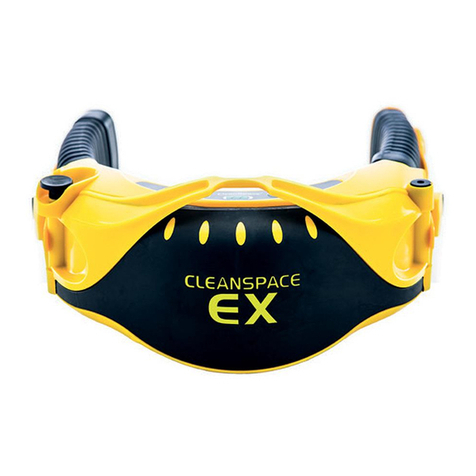
CleanSpace
CleanSpace EX User manual
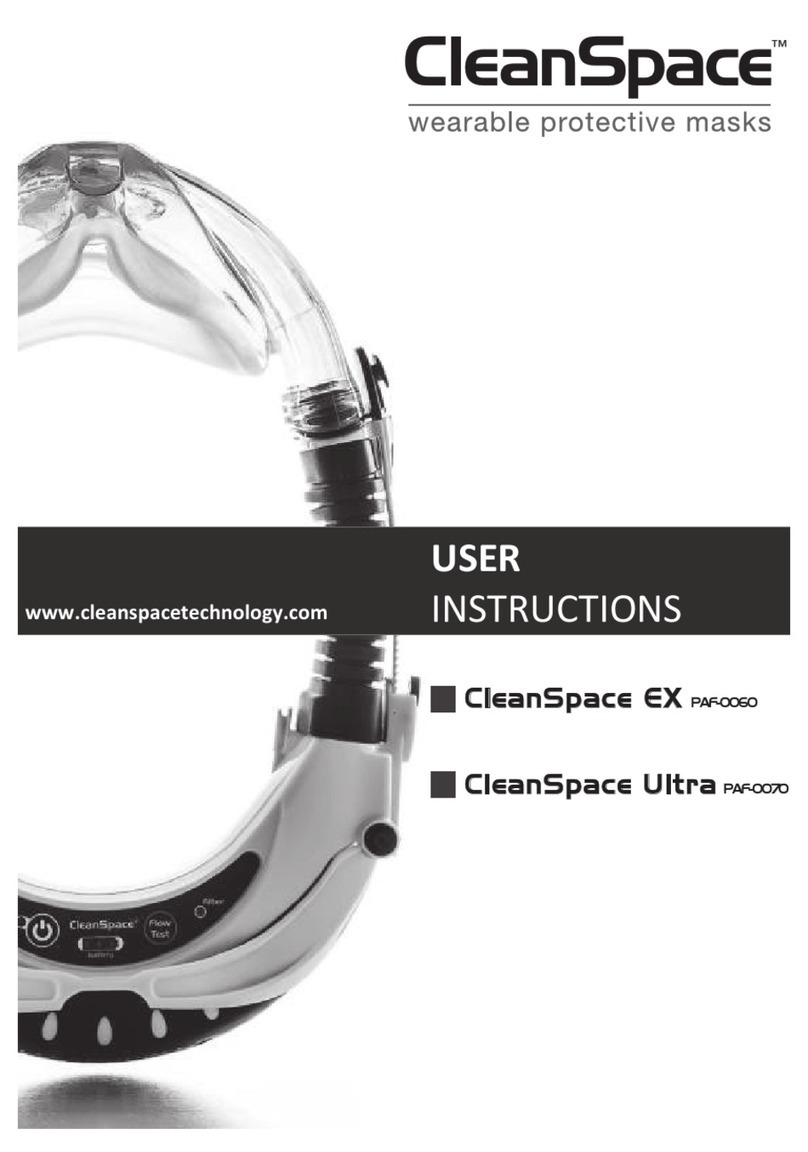
CleanSpace
CleanSpace PAF-0060 User manual
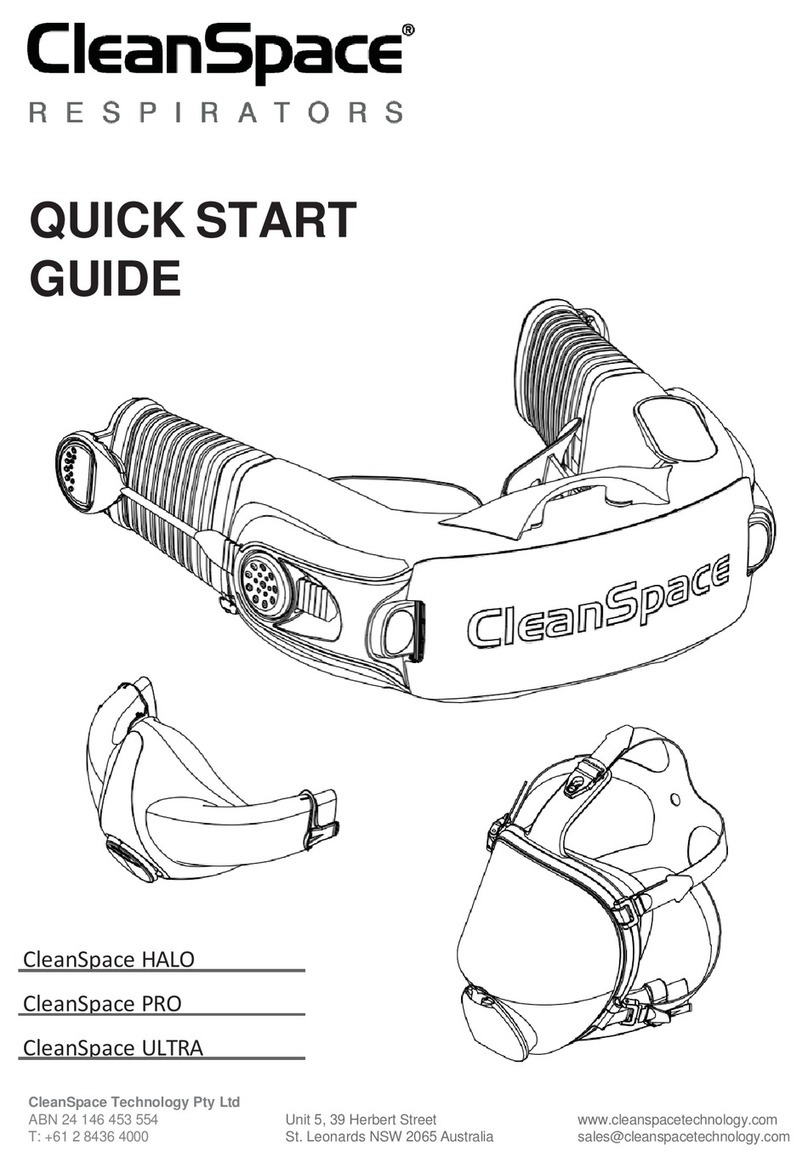
CleanSpace
CleanSpace HALO User manual
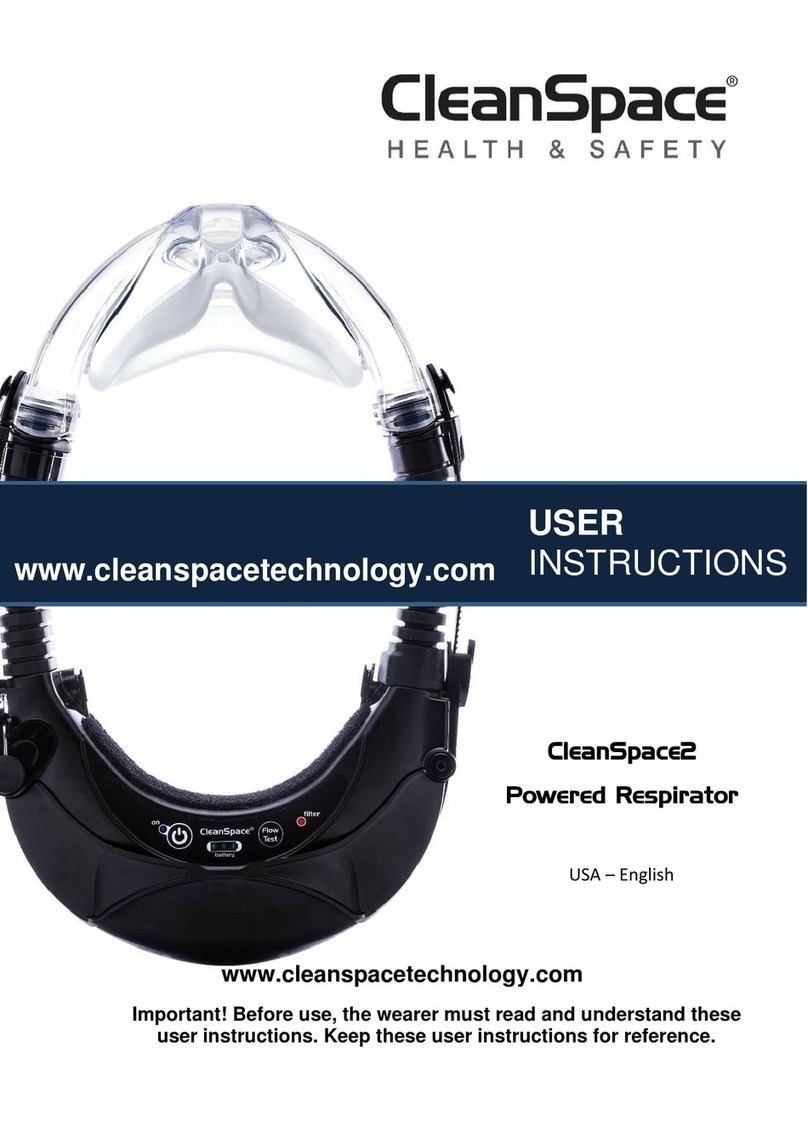
CleanSpace
CleanSpace CleanSpace2 User manual

CleanSpace
CleanSpace CleanSpace2 Installation instructions

CleanSpace
CleanSpace PRO User manual
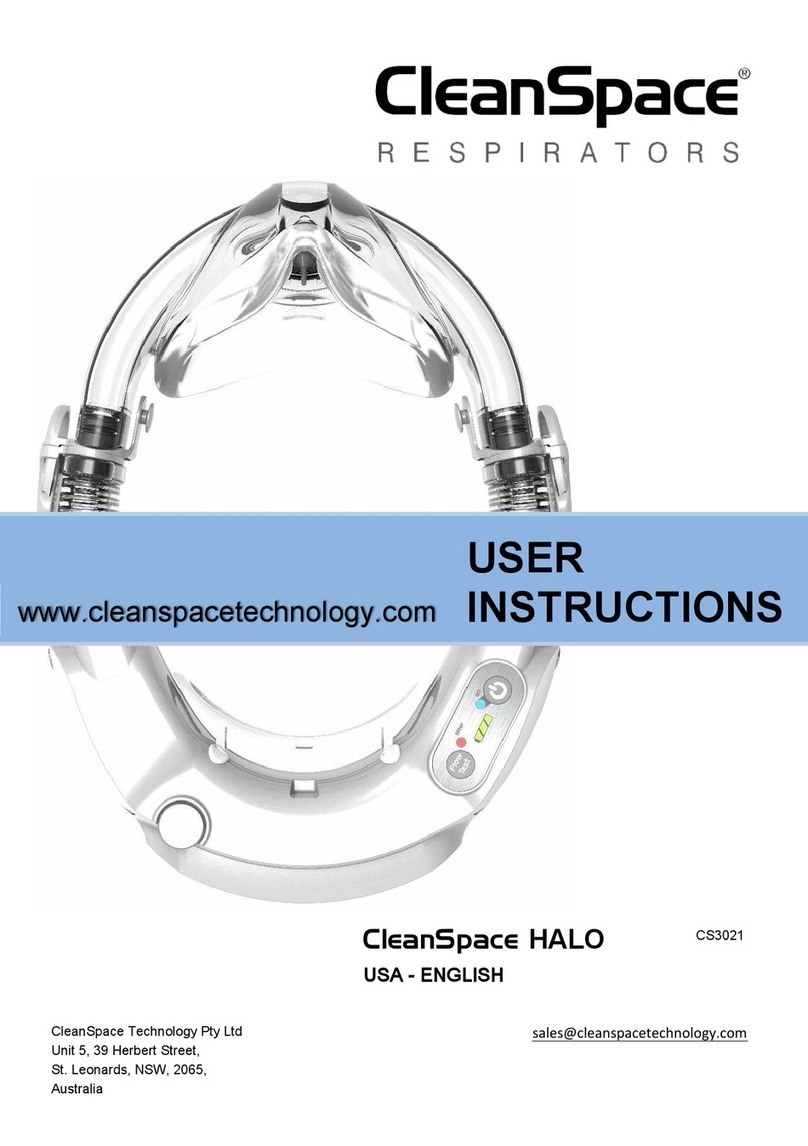
CleanSpace
CleanSpace CS302 User manual

CleanSpace
CleanSpace CleanSpace2 User manual

CleanSpace
CleanSpace ULTRA Installation instructions

CleanSpace
CleanSpace HALO CS3021 with BIO-HOOD User manual


